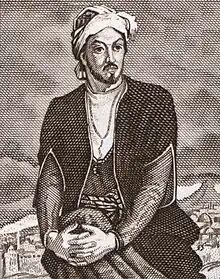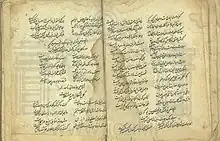Imadaddin Nasimi
Seyid Ali Imadaddin Nasimi (Azerbaijani: Seyid Əli İmadəddin Nəsimi, سئید علی عمادالدّین نسیمی; c. 1369/70 – c. 1418/19), commonly known as Nasimi[lower-alpha 1] (Nəsimi, نسیمی), was a 14th- and 15th-century Hurufi poet who composed poetry in his native Azerbaijani, as well as Persian and Arabic languages. He is regarded as one of the greatest Turkic poets of his time and one of the most prominent figures in Azerbaijani literature.
Nasimi | |
|---|---|
 Depiction by Mikayil Abdullayev, 1973 | |
| Born | Seyid Ali Imadaddin Nasimi c. 1369/70 |
| Died | c. 1418/19 Aleppo, Mamluk Sultanate (now Syria) |
| Occupation | Poet |
| Language | |
Born around 1369–70, Nasimi received a good education and was drawn to Sufism at an early age. After becoming a faithful adherent of the Hurufism movement, Nasimi left Azerbaijan to spread Hurufism in Anatolia and later Aleppo following the execution of its founder and Nasimi's teacher, Fazlallah Astarabadi. In Aleppo, he gained followers as a Hurufi sheikh but faced resistance from Sunni circles who eventually convinced the Mamluk sultan to order his death for his religious beliefs around 1418–19. Nasimi was executed and buried in a takkah (Sufi lodge) in Aleppo.
His surviving works include two dīvāns (collections of poems) in Azerbaijani and Persian, along with some poems in Arabic. Nasimi's poems mainly centre around Hurufism and contain many references to Islamic texts. His poetry combines harmonious melodies and easily understood expressions with more complex topics related to religion. Nasimi had great influence on Turkic literature and influenced many major future poets such as Habibi, Haqiqi (pen name of Jahan Shah), Khatai (pen name of Ismail I), among others. He is also considered the founder of Azerbaijani classical 'arūz̤ poetry (poetry using quantifying prosody) and ghazal poetry (a form of love poetry), as well as the first lyric poet in Oghuz Turkic classic literature.
Name
Nasimi's given name was Ali,[2] but he adopted the epithet (laqab) Imadaddin,[lower-alpha 2] which superseded his original name in use.[3] Some sources attribute other names to him, such as Nesîmüddin, Celâleddin and Ömer.[6]
His most prevalent pen name was Nasimi. Its etymology is disputed but most plausibly explained as an echo of Naimi, the pen name of Nasimi's teacher Fazlallah Astarabadi.[2] It may also have been derived from the Arabic word nasim, meaning "breeze, breath of wind".[7] He also employed other pen names sporadically, such as Hüseyni, Haşimi, Seyyid, Ali and İmad.[8] His epithet "Imadaddin" or the title "seyid" (marking his claim of descent from the Islamic prophet Muhammad) are often added in order to distinguish him from other figures who also bore the name Nasimi.[2]
Biography
Much of Nasimi's life is considered obscure. His year of birth is uncertain, but it is commonly assumed to be 1369–70 without conclusive evidence.[2] His exact birthplace is also contested: it has been argued as Shamakhi, Tabriz, Baghdad, Aleppo, Shiraz or Diyarbakır.[9] He was of Azerbaijani Turkic origin[10] and spoke Azerbaijani as his native language,[11] as well as fluent Persian and Arabic.[2]
Nasimi had a good education as a child and pursued Sufism at an early age.[6] While in Tabriz, he met the mystic Fazlallah Astarabadi who introduced him to Hurufism. Nasimi stayed with him in Baku and Shirvan for some time and became one of the most faithful adherents of the Hurufism movement, as well as Astarabadi's successor (khalifa).[12] After the Timurid emperor Miran Shah executed Astarabadi for his religious views, Nasimi left Azerbaijan and travelled to Anatolia to spread Hurufism. He arrived in Bursa during Murad I’s (r. 1362–1389) reign but was not welcomed there. He also attempted to meet the Sufi saint Haji Bayram Veli in Ankara but was turned away because of his Hurufi beliefs.[13]

Unable to find a suitable environment for his beliefs in Anatolia, he went to Aleppo, which was the main centre of Hurufis in Syria at that time. Islamic scholar Ibn Hajar al-Asqalani wrote about Nasimi's activity in Aleppo as a Hurufi sheikh and his increasing followers. He used his poetry skills to further spread his beliefs. His ideas, such as "the human face being the manifestation of God" and "describing all the body organs with letters"[lower-alpha 3] faced resistance in Sunni circles.[3] In Aleppo, Nasimi continued to fight for freedom of expression through his poetry, challenging strict rules and religious intolerance.[15] Some contemporary Arab sources say that a group of Sunni Muslim scholars who followed the main schools of law tried to get Nasimi killed by the Mamluk deputy of Aleppo based on vague rumours, but they failed. The deputy then reportedly referred the case to the Mamluk sultan Al-Mu'ayyad Shaykh (r. 1412–1421) in Cairo, who ordered Nasimi's death, likely due to his religious beliefs; Nasimi is sometimes referred to as a kafir, or unbeliever.[2] According to the Turkologist Michael Hess, while some sources claim that Nasimi was killed by being flayed alive, there is no clear evidence of this in contemporary sources. Some texts do mention flaying, but it may have been done posthumously for the purpose of public display.[2] The most likely year of execution is 1418–9, although some historians suggest 1417 and other dates have also been proposed.[2] Nasimi's body was buried in a takkah (Sufi lodge) named after him in Aleppo.[16]
Nasimi's execution is believed to have had a political component due to his Turkic ancestry which brought him closer to Mamluks' rival Turkic dynasties in Syria and Anatolia. According to Hess, Al-Mu'ayyad's order to distribute pieces of Nasimi's body to local Turkic rulers like the Dulkadir and the Aq Qoyunlu was motivated by politics.[2]
Poetry

Nasimi's surviving works include two dīvāns (collections of poems), one in Azerbaijani and the other in Persian.[17] Although the 16th-century Ottoman poet and bibliographer Latifî claimed that Nasimi had a "dīvān in all three languages", implying the existence of an Arabic dīvān as well, no evidence of such a work has been found.[18] His Azerbaijani dīvān contains over four hundred ghazals (a form of love poetry) and several hundred other poems, including mas̱navīs (a poem written in rhyming couplets) and quatrains (a four-line poem).[3] According to the Turkologist Kathleen Burrill, Nasimi was able to maintain the quality of his Azerbaijani language in his poetry while using the 'arūz̤ form (poetry using quantifying prosody). This sets him apart from later poets who relied heavily on borrowing from Persian because of what Burrill described as their "lack of skill" in mastering the 'arūz̤ form.[19] His Persian dīvān consists of almost three hundred ghazals and discusses topics such as Hurufism, praise to Twelve Imams and Imam Ali, as well as Fazlallah Astarabadi.[3]
Nasimi's writing style often involves repeating sounds and grammatical patterns. His poems mainly centre around Hurufism and contain many references to Islamic texts such as the Quran. However, some of the beliefs behind his poems fall outside of mainstream Islam. Michael Hess states that Nasimi's poetry blends easily comprehensible language with more intricate themes related to Hurufism. Hess also notes that while Fuzuli's poems have remained popular due to their emotional depth and technical proficiency, the concepts behind them are not as widely understood.[2] Burrill notes that some of Nasimi's poems can be difficult to read due to their complex religious references, when this is not the case, they convey his themes of love through "easy-flowing, harmonious melodies".[20]
Legacy

Nasimi is considered one of the greatest figures of Turkic literature.[20] According to the modern scholar Sakina Berengian, Nasimi was the first major poet not only in Azerbaijani literature but also in all of Turkic literature.[21] His influence on poetry extended throughout the Turkic world and impacted major poets such as Habibi, Haqiqi (pen name of Jahan Shah), Khatai (pen name of Ismail I), and others.[22] Nasimi is also regarded as the founder of Azerbaijani classical 'arūz̤ poetry, ghazal poetry, as well as the first lyric poet in Oghuz Turkic classic literature.[23] His works had a significant impact on the development of both Azerbaijani and Ottoman literature.[24] Nasimi's style has greatly influenced the general style of Azerbaijani poetry.[25] According to the professors of Turkish literature Azmi Bilgin and İlyas Üzüm, the Timurid poet Ali-Shir Nava'i's words of praise about Nasimi show that he was also considered an "important personality in the Central Asian Turkic world".[3]
In 1973, UNESCO declared the 600th anniversary of Nasimi's birth to be celebrated worldwide. Representatives from many countries participated in the celebrations held in Baku and Moscow.[26] In Azerbaijan, 2019 was declared the "Year of Nasimi" to commemorate the 650th anniversary of the poet's birth.[27] A street, a metro station, and a district in Baku are also named after Nasimi. The National Institute of Linguistics of Azerbaijan is also named in his honour. Additionally, there is a 1973 Azerbaijani biopic film about his life.
In 2019, an asteroid that was discovered at Kleť Observatory in 1995 was named "32939 Nasimi" in honour of the poet.[28]
References
Notes
Citations
- Burrill 1972, p. 17; Britannica 2023.
- Hess 2021.
- Bilgin & Üzüm 2007.
- Doerfer 1988.
- Mir-Kasimov 2022, p. 276.
- Bilgin & Üzüm 2007; Usluer 2013.
- Burrill 1972, p. 26.
- Usluer 2013.
- Bilgin & Üzüm 2007; Usluer 2013; Burrill 1972, pp. 18–19, 27.
- Doerfer 1988; Balan 2008; Burrill 1972, p. 46.
- Gümüş 2020, p. 238.
- Hess 2021; Bilgin & Üzüm 2007; Javadi & Burrill 1988.
- Bilgin & Üzüm 2007; Usluer 2013; Burrill 1972, p. 21, 30.
- Algar 2004.
- Asgharzadeh 2007, p. 10.
- Bilgin & Üzüm 2007; Watenpaugh 2004, p. 126; Burrill 1972, p. 27.
- Hess 2021; Gümüş 2020, p. 4.
- Bilgin & Üzüm 2007; Usluer 2013; Burrill 1972, p. 32.
- Burrill 1972, p. 57.
- Burrill 1972, p. 53.
- Berengian 1988, p. 39.
- Hess 2021; Bilgin & Üzüm 2007; Burrill 1972, p. 76.
- Burrill 1972, p. 53; Hess 2016.
- Javadi & Burrill 1988; Berengian 1988, p. 16.
- Burrill 1972, p. 76.
- Bilgin & Üzüm 2007; Ismayilova 2019.
- UNESCO 2019.
- Isabalayeva 2019.
Sources
- Algar, Hamid (2004). "Horufism". In Yarshater, Ehsan (ed.). Encyclopædia Iranica, Volume XII/5: Homosexuality III–Human migration II. London and New York: Routledge & Kegan Paul. pp. 483–490. ISBN 978-0-933273-79-5.
- Asgharzadeh, Alireza (December 2007). "In Search of a Global Soul: Azerbaijan and the Challenge of Multiple Identities" (PDF). Middle East Review of International Affairs. 11 (4): 7–18. Archived (PDF) from the original on 27 April 2023. Retrieved 11 April 2023.
- Balan, Canan (1 July 2008). "Transience, absurdity, dreams and other illusions: Turkish shadow play". Early Popular Visual Culture. 6 (2): 171–185. doi:10.1080/17460650802150424. ISSN 1746-0654. S2CID 191493938.
- Berengian, Sakina (1988). Azeri and Persian Literary Works in Twentieth Century Iranian Azerbaijan. K. Schwarz. ISBN 978-3-922968-69-6.
- Bilgin, Azmi & Üzüm, İlyas (2007). "Nesîmî". TDV Encyclopedia of Islam, Vol. 33 (Nesi̇h – Osmanlilar) (in Turkish). Istanbul: Turkiye Diyanet Foundation, Centre for Islamic Studies. ISBN 978-975-389-455-5.
- Burrill, Kathleen R. F. (1972). The Quatrains of Nesimî Fourteenth-Century Turkic Hurufi. De Gruyter. ISBN 978-3-11-087896-7.
- Doerfer, Gerhard (1988). "Azerbaijan viii. Azeri Turkish". In Yarshater, Ehsan (ed.). Encyclopædia Iranica, Volume III/3: Azerbaijan IV–Bačča(-ye) Saqqā. London and New York: Routledge & Kegan Paul. pp. 245–248. ISBN 978-0-71009-115-4.
- Gümüş, Kudret Safa (2020). "Nesîmî ve Şeyhî'ni̇n "Yok" Redi̇fli̇ Gazelleri̇ne Mukayeseli̇ Bi̇r Bakış" [A Comparative Overview on the "Yok" Ghazals Written With Repeated Voice of Nesi̇mi̇ and Şeyhi̇]. TÜRÜK Uluslararası Dil, Edebiyat ve Halkbilimi Araştırmaları Dergisi (in Turkish). 8 (23): 236–252. doi:10.12992/turuk1052. ISSN 2147-8872. S2CID 234894220. Archived from the original on 15 March 2023. Retrieved 16 March 2023.
- Hess, Michael R. (2016). "Gazel (Qəzəl) in Azerbaijani literature". In Fleet, Kate; Krämer, Gudrun; Matringe, Denis; Nawas, John; Rowson, Everett (eds.). Encyclopaedia of Islam (3rd ed.). Brill Online. doi:10.1163/1573-3912_ei3_COM_27386. ISSN 1873-9830.
- Hess, Michael R. (2021). "Nǝsimi, İmadǝddin". In Fleet, Kate; Krämer, Gudrun; Matringe, Denis; Nawas, John; Rowson, Everett (eds.). Encyclopaedia of Islam (3rd ed.). Brill Online. doi:10.1163/1573-3912_ei3_COM_40738. ISSN 1873-9830.
- Isabalayeva, Ilhama (4 June 2019). "Planet named after Azerbaijani poet Imadaddin Nasimi". Trend News Agency. Retrieved 16 July 2023.
- Ismayilova, Laman (3 December 2019). "Nasimi's poetry presented in Latvia". Azernews. Archived from the original on 15 March 2023. Retrieved 15 March 2023.
- Javadi, H.; Burrill, K. (1988). "Azerbaijan x. Azeri Turkish Literature". In Yarshater, Ehsan (ed.). Encyclopædia Iranica, Volume III/3: Azerbaijan IV–Bačča(-ye) Saqqā. London and New York: Routledge & Kegan Paul. pp. 251–255. ISBN 978-0-71009-115-4.
- "Seyid İmadeddin Nesimi". Encyclopædia Britannica. Archived from the original on 14 May 2008. Retrieved 15 March 2023.
- Mir-Kasimov, Orkhan (2022). Ali.The Well-Guarded Secret: Figures of the First Master in Shi'i Spirituality. Shii Islam: Texts and Studies. Vol. 3. Brill. pp. 265–287. doi:10.1163/9789004522435_013. ISBN 978-90-04-52242-8.
- "President Ilham Aliyev declares 2019 as Year of Nasimi". National Commission of the Republic of Azerbaijan for UNESCO. 14 January 2019. Archived from the original on 6 July 2023. Retrieved 6 July 2023.
- Usluer, Fatih (2013). "Nesîmî, Şeyh İmâdüddîn Seyyid Nesîmî". Türk Edebiyatı İsimler Sözlüğü (in Turkish). Ahmet Yesevi University. Archived from the original on 16 March 2023. Retrieved 16 March 2023.
- Watenpaugh, Heghnar Zeitlian (1 January 2004). "The Decentering of Patronage: Dervish Lodges and Endowments of the Seventeenth Century". The Image of an Ottoman City: 123–174. doi:10.1163/9789047404224_009. ISBN 978-90-474-0422-4. S2CID 242585469.
External links
 Azerbaijani Wikisource has original text related to this article: İmadəddin Nəsimi
Azerbaijani Wikisource has original text related to this article: İmadəddin Nəsimi Media related to Nasimi at Wikimedia Commons
Media related to Nasimi at Wikimedia Commons